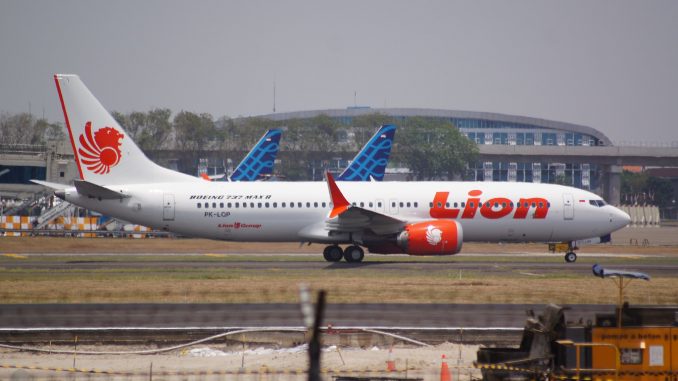
The NTSC (National Transportation Safety Committee) of Indonesia has on Friday published its final report on the crash of Lion Air flight JT610, which occurred on almost one year ago 29th October 2018. It was the first fatal accident of the Boeing 737 MAX, which in turn lead to the type’s international grounding following the crash of Ethiopian Airlines Flight ET302 on 10th March 2019.
The 353-page report concludes that there were a number of factors at play in the downing of the aircraft, which lead to the loss of all 189 souls on board when it plunged into the Java sea just 13 minutes after taking-off at Jakarta International Airport. A key contributor to the fatal accident was, as previously suspected, Boeing’s new software system to avoid a stall – the same thing is highly likely to have caused the Ethiopian Airlines crash in March this year, as a preliminary report published in April states.
Due to the increased engine size of the 737 MAX over previous models of the 50+ year old aircraft family, the engines themselves are mounted further forwards and higher on the wing in order to maintain clearance from the ground. The result of such is that the aircraft can have a tendency to pitch up more than previous models. In order to counteract this, Boeing developed the Maneuvering Characteristics Augmentation System or MCAS. The system automatically pitches the nose of the plane down using the elevator trim to prevent the aircraft from entering a stall. Crews were not informed about MCAS in their training modules for the new jet, and in an unprecedented cost-cutting move, the system relied on a single Angle-of-Attack indicator to operate, instead of having using to sensors to have one backup.
In the flights prior to the accident flight, data showed issues with the aircraft’s angle-of-attack (AoA) sensor, which directly feeds information to MCAS. In turn, MCAS was erroneously activated on the previous flight, where the crew (which had an off-duty 737 pilot in the cockpit jump seat) managed to disable the Stabilizer Trim as per the ‘runaway stabilizer trim’ checklist. The aircraft landed safely in Jakarta, although the NTSC criticised the crew for not landing as soon as possible, given the nature of the problem. It also states that during the onset of the issue, the stall warning Stick Shaker was activated.
Once the aircraft had landed, the crews reported the problem with the AoA sensor to maintenance. They did, however, fail to report the activation of the Stick Shaker which would have stressed the gravity of the situation. The maintenance crews replaced the faulty sensor on the left of the aircraft (which feeds data to MCAS – the secondary unit on the right of the nose does not) with a unit which was refurbished by a Xtra Aerospace in Miramar, Florida. It turns out that this unit was also faulty, and had a 21 degree bias which activated MCAS as soon as the crew retracted the flaps after take-off on the fateful flight. It is also reported that the maintenance crews did not perform a test of the replacement unit as-per requirements prior to the aircraft’s return to flight – handing it back over as ‘airworthy’.
The crew of the accident flight lacked the experience (and extra pair of eyes) in the cockpit and failed to follow the ‘runaway stabilizer checklist’, which would have disabled MCAS and allowed them to regain control and prevent the aircraft from nose-diving into the sea. The crews were also unaware of the issues on the previous flight, and because the cockpit warning light to warn of the two AoA sensors providing conflicting information (AoA disagree) was optional and not installed on the accident aircraft, the crew had little time to deal with a situation they weren’t prepared for – a problem compounded by the fact that Boeing had not informed crews about the existence of MCAS in the first place.
In the light of the report, the United States Federal Aviation Administration (FAA) have revoked Xtra Aerospace’s maintenance certificate. The design flaws found in the Boeing 737 MAX are currently being resolved by Boeing during the type’s worldwide grounding. Boeing says it expects the type to return to flight at the end of the year, and also issued a statement in response to the NTSC’s report. Boeing President and CEO Dennis Muilenburg said “We commend Indonesia’s National Transportation Safety Committee for its extensive efforts to determine the facts of this accident, the contributing factors to its cause and recommendations aimed toward our common goal that this never happens again.”
“We are addressing the KNKT’s [Indonesian for NTSC] safety recommendations, and taking actions to enhance the safety of the 737 MAX to prevent the flight control conditions that occurred in this accident from ever happening again.”
The 737 MAX is the fourth and latest generation of Boeing’s 737. It performed its maiden flight on 29th January 2016 and first entered commercial service in May 2017 with Malindo Air, a subsidiary of Lion Air. Almost 400 aircraft were already delivered to customers prior to the grounding in March. Boeing has since suspended deliveries and is currently storing hundreds of newly built 737 MAX, as they await a lifting of the grounding through an FAA certification of the aircraft manufacturer’s updates for the jet.
Matt is a Berlin-based writer and reporter for International Flight Network. Originally from London, he has been involved in aviation from a very young age and has a particular focus on aircraft safety, accidents and technical details.



